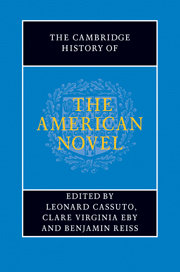Book contents
- Frontmatter
- General Introduction
- PART ONE INVENTING THE AMERICAN NOVEL
- PART TWO REALISM, PROTEST, ACCOMMODATION
- Introduction: realism, protest, accommodation
- 17 Realism and radicalism: the school of Howells
- 18 James, pragmatism, and the realist ideal
- 19 Theories of the American novel in the age of realism
- 20 The novel in postbellum print culture
- 21 Twain, class, and the Gilded Age
- 22 Dreiser and the city
- 23 Novels of civic protest
- 24 Novels of American business, industry, and consumerism
- 25 New Americans and the immigrant novel
- 26 Cather and the regional imagination
- 27 Wharton, marriage, and the New Woman
- 28 The postbellum race novel
- 29 The African American novel after Reconstruction
- 30 The rise of naturalism
- 31 Imagining the frontier
- 32 Imperialism, Orientalism, and empire
- 33 The hemispheric novel in the post-revolutionary era
- 34 The woman's novel beyond sentimentalism
- 35 Dime novels and the rise of mass-market genres
- 36 Readers and reading groups
- PART THREE MODERNISM AND BEYOND
- PART FOUR CONTEMPORARY FORMATIONS
- A selected bibliography
- Index
34 - The woman's novel beyond sentimentalism
from PART TWO - REALISM, PROTEST, ACCOMMODATION
Published online by Cambridge University Press: 28 July 2011
- Frontmatter
- General Introduction
- PART ONE INVENTING THE AMERICAN NOVEL
- PART TWO REALISM, PROTEST, ACCOMMODATION
- Introduction: realism, protest, accommodation
- 17 Realism and radicalism: the school of Howells
- 18 James, pragmatism, and the realist ideal
- 19 Theories of the American novel in the age of realism
- 20 The novel in postbellum print culture
- 21 Twain, class, and the Gilded Age
- 22 Dreiser and the city
- 23 Novels of civic protest
- 24 Novels of American business, industry, and consumerism
- 25 New Americans and the immigrant novel
- 26 Cather and the regional imagination
- 27 Wharton, marriage, and the New Woman
- 28 The postbellum race novel
- 29 The African American novel after Reconstruction
- 30 The rise of naturalism
- 31 Imagining the frontier
- 32 Imperialism, Orientalism, and empire
- 33 The hemispheric novel in the post-revolutionary era
- 34 The woman's novel beyond sentimentalism
- 35 Dime novels and the rise of mass-market genres
- 36 Readers and reading groups
- PART THREE MODERNISM AND BEYOND
- PART FOUR CONTEMPORARY FORMATIONS
- A selected bibliography
- Index
Summary
In her autobiography, A Backward Glance (1934), Edith Wharton cites her inspiration for the gritty realism of her 1911 novel, Ethan Frome, as a desire to revise the depiction of the New England landscape as seen through the “rose-coloured spectacles” of her predecessors, Sarah Orne Jewett and Mary Wilkins Freeman. In so doing, she appears to cast these regional artists, somewhat inaccurately, as sentimentalists. Elsewhere in the memoir she comments on the “laxities of the great Louisa” May Alcott, a writer to whom that epithet might more appropriately be applied, since contemporary responses to her work tended to note the “limited field” of her “charming and homely” domestic settings, whilst praising the “moral purpose” of the simple, straightforward stories “which her own sex find especially delightful.” Wharton's interpretation of the generic affiliations of her antecedents may be inconsistent, but her disparagement of the achievements of these “authoresses” and her determination to distinguish her work from theirs speaks clearly of the burden placed upon a generation of artists by the legacy of a by then widely discredited tradition. Writing in the wake of sentimentalism, Wharton and many of her female contemporaries faced a particular challenge – how to negotiate a marginalized female literary tradition in order to establish a credible presence in the artistic life of the nation?
- Type
- Chapter
- Information
- The Cambridge History of the American Novel , pp. 571 - 585Publisher: Cambridge University PressPrint publication year: 2011



